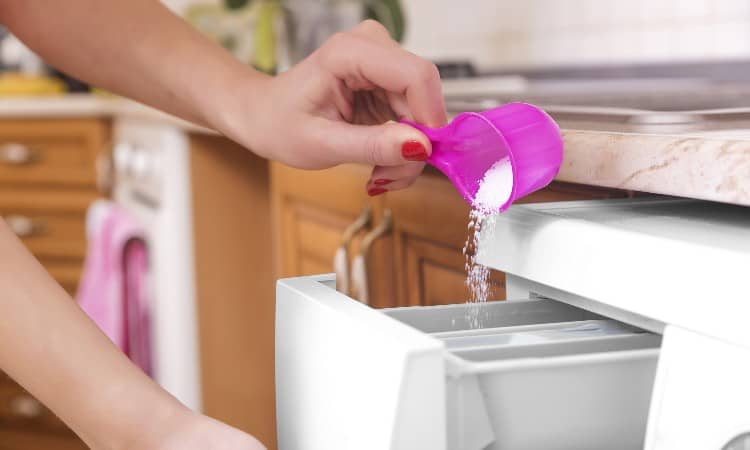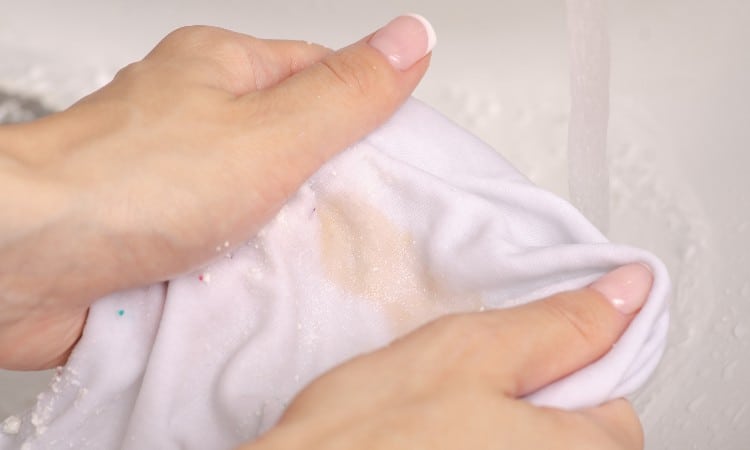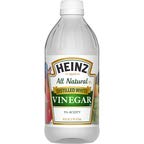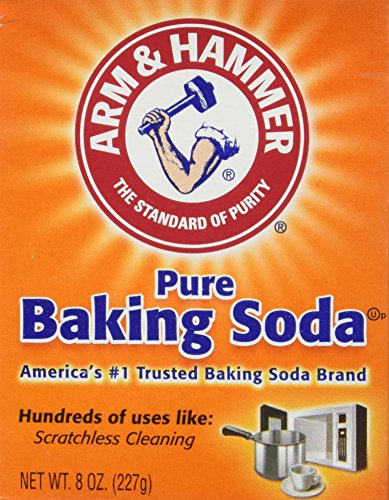Have you ever taken your clothing out of the washing machine and noticed a stain that wasn’t there before? If you’re wondering what it could possibly be, then the answer is probably laundry detergent. Don’t worry though, those stains can be easily removed with a few household products.
Rubbing alcohol, vinegar, baking soda, dish soap, and bar soap can all be used to remove detergent stains from clothes. You’ll need to treat the stain and wash it again, making sure that you use the right cycle to properly agitate and rinse away the stain and the product used to treat it.
But wait, why did detergent stain your clothes? Isn’t it supposed to help remove stains instead? In this article, I’ll explain some of the potential causes of laundry detergent stains can be. I’ll also explain more details regarding how to get detergent stains out of clothes.

Can Laundry Detergent Stain Clothes?
It may seem counterintuitive that laundry detergent can stain clothes. But it can happen. Laundry detergent “stains” more closely resemble a greasy spot that may or may not be colored depending on the detergent’s color and the stained clothing.
Laundry detergent stains can be easily removed when you notice them, but what causes the stain in the first place? Let’s look at a few potential causes so that you can identify what the issue might have been.
Overloading Your Washing Machine
One cause of detergent stains is caused by stuffing too many clothes in your washing machine at once. Yes, most washing machines can indeed be filled to the top with clothes, but that doesn’t mean that they should be.
The chances for laundry detergent stains increase when you put more clothes in the washing machine because the clothes are packed more closely together. This makes it much harder for the detergent to be dispersed evenly among the clothes, meaning that it just sits on top of some of them.
Secondly, when it’s harder for clothes to move around, they can’t rinse properly. As a result, detergent sometimes gets left in the clothes. In this case, the stains are due to detergent being left behind.
Using Too Much Detergent
Using too much detergent can also leave stains behind, especially if you’re consistently using too much. The amount of laundry detergent you use should be proportional to the number of clothes you have in your washing machine.
Using enough detergent for a full load of clothes when you only have half a load in the washing machine can mean that the detergent may not get rinsed out all the way. And if this is something that is done regularly, it can lead to a buildup of product inside the fibers of your clothes or the washing machine itself. This buildup of detergent is more likely to leave a stain.
Improper Agitation
Agitation in a washing machine provides two functions. The first function is to help dissolve or disperse the detergent into the water, and the second function is to rinse the detergent out of the clothes after the wash cycle.
If the wrong cycle is used, providing less agitation, it can cause the detergent to not be dispersed or rinsed out. This is especially true in the winter, when colder air and water can cause detergent to dissolve more slowly.
Using Powdered Detergent With Hard Water
The final cause of detergent stains left behind on clothes is if you have hard water and use a powdered detergent. Having hard water isn’t your fault, but it can interfere with the detergent dissolving properly.
As I’m sure you’ve gathered from the other causes, the detergent that doesn’t dissolve may remain on one certain piece of clothing and not be dispersed properly. Powdered detergent stains are noticeable, particularly on darker clothing, so this could be the problem if you notice that your darker clothes have stains when they come out of the washing machine.
Can You Get Detergent Stains Out of Clothes?
Although detergent stains look greasy, and grease stains are notoriously difficult to remove from clothes, the stains left behind by laundry detergent are pretty easy to remove. However, the key is to check your clothes before putting them in the dryer, as heat can set stains. If this happens, then even detergent stains will be more difficult or even impossible to remove.
If you do notice a detergent stain, you will want to rewash it immediately. This will give you the best chance of actually getting that stain to come out of your clothes. But, you will want to treat the stain before washing it again to increase the chances that the stain does come out. Luckily, you don’t have to go out and get a special stain remover, as there are some products that you can use that you probably already have at home.
How to Get Detergent Stains Out of Clothes: Six Methods

When it comes to removing detergent stains, there are five household products that, combined with a little agitation, are very effective stain removal agents. Some of these treatments work best with particular types of detergent, but at the end of the day, they’ve all proven to do their intended purpose very well. Here’s how to use each one of them.
1. Rubbing Alcohol
 Rubbing alcohol is one of the most popular stain removers for laundry detergent stains because it effectively removes both powdered and liquid laundry detergent. Rubbing alcohol is effective because it is powerful enough to break down the stain but gentle enough to not damage your clothes. Follow these steps to learn how to use them.
Rubbing alcohol is one of the most popular stain removers for laundry detergent stains because it effectively removes both powdered and liquid laundry detergent. Rubbing alcohol is effective because it is powerful enough to break down the stain but gentle enough to not damage your clothes. Follow these steps to learn how to use them.
- Fill a sink or washtub with warm water and soak the garment.
- Rub the spot with your finger or a soft rag to see if you can get any of the detergent out before using alcohol.
- If the stain is still visible, gently squeeze excess water out of the garment. Be sure not to wring out the fabric, especially with delicate fabrics that could stretch or break.
- Dip a cotton swab into the rubbing alcohol and do a spot test on the inside of the fabric. This is to ensure that the alcohol does not damage the fabric in any way. Wait a few minutes before proceeding just to be sure.
- If no damage to the fabric occurred, soak a sponge or rag in rubbing alcohol and squeeze or rub the alcohol onto the stain. Avoid directly pouring the alcohol onto the stain so that you don’t accidentally use too much.
- Let the alcohol sit on the stain for about 15 minutes to give it plenty of time to break down the stain.
- Rinse the alcohol out of the garment to check for stain removal.
- Even if the stain hasn’t broken down fully, you can wash it in the washing machine without detergent. The rest of the stain should be removed.
- If the stain is still there after washing, repeat the procedure.
- Once the stain has been removed, you can dry the garment.
2. Vinegar
 Vinegar is the unsung laundry hero because it is effective at removing stains and removing odors and brightening clothes. It should be no surprise that vinegar can also be used to remove stains left behind by laundry detergent. Vinegar works because it is very acidic and can eat away at the stain. And when mixed with water to dilute it, vinegar won’t cause any permanent damage to your clothes. Here’s how to use it.
Vinegar is the unsung laundry hero because it is effective at removing stains and removing odors and brightening clothes. It should be no surprise that vinegar can also be used to remove stains left behind by laundry detergent. Vinegar works because it is very acidic and can eat away at the stain. And when mixed with water to dilute it, vinegar won’t cause any permanent damage to your clothes. Here’s how to use it.
- Fill a sink or washtub with warm water if the fabric can withstand warm temperatures. If not, use cool water instead.
- Add 1 cup of white white vinegar to the water and use your hand to help evenly distribute the vinegar.
- Submerge your stained garment in the water and let it soak for one hour.
- While the garment soaks, check it every 10 to 15 minutes and rub your finger over the stain to help remove what the vinegar has already broken down.
- After the hour is up, gently squeeze the excess water out of the fabric. You may notice that your clothing has a slight vinegar smell, but the smell should come out during the wash and as the fabric dries.
- After squeezing out the excess water, toss the garment into the washing machine and wash it as you normally would, except without the use of detergent.
- Check the fabric after the wash to make sure that the stain has been fully removed. If not, repeat the procedure.
- Dry the garment once the stain has been removed.
3. Baking Soda
 Another unsung laundry hero is baking soda, and it works directly in your washing machine as you wash the clothes. Baking soda can help absorb and remove stains and deodorize them to remove any smells (which can happen with laundry detergent buildup). Baking soda can also help remove any detergent buildup in your washing machine as well. Follow these steps to use this method.
Another unsung laundry hero is baking soda, and it works directly in your washing machine as you wash the clothes. Baking soda can help absorb and remove stains and deodorize them to remove any smells (which can happen with laundry detergent buildup). Baking soda can also help remove any detergent buildup in your washing machine as well. Follow these steps to use this method.
- If you’ve noticed a detergent stain upon removing your clothing from the wash, remove the other clothes from the washing machine and place any stained garments back into the machine.
- Do not add laundry detergent to the machine. You will want to add ½ cup of baking soda directly into the wash.
- Use the same machine settings that you normally would when you wash those particular clothes.
- Start the washing machine and let it run through the entire process. If you wish, you can add 1 cup of vinegar to the rinse cycle (or add it into the fabric softener dispenser before the wash to be released at the appropriate time). Vinegar will provide extra stain-removing power.
- Once the washing machine has finished, check the clothing to make sure that the stain has been removed. Repeat the process, if necessary.
- Dry the clothing once the stain is no longer visible. If you used vinegar, any residual odor should go away at this point.
4. Bar Soap
 If you don’t have any rubbing alcohol or vinegar or just don’t trust them not to damage your clothing, you can also use bar soap to remove detergent stains. Castile soap works best, but you can use any plain, unscented bar soap. It’s also a common ingredient in homemade laundry soaps, so it makes sense that it is an effective stain remover for commercial laundry detergents. Here’s how to use it.
If you don’t have any rubbing alcohol or vinegar or just don’t trust them not to damage your clothing, you can also use bar soap to remove detergent stains. Castile soap works best, but you can use any plain, unscented bar soap. It’s also a common ingredient in homemade laundry soaps, so it makes sense that it is an effective stain remover for commercial laundry detergents. Here’s how to use it.
- Fill a sink with cold water, or simply run cold water over the clothes. You just want to make sure that the fabric is soaked, especially where the stain is.
- Rub the soap over the stained area of clothing.
- Work the soap into the stain by using your fingers or rubbing the fabric together.
- Rinse the clothing under cold water to remove the soap residue. You may have to rinse several times to get all of it out.
- Drain the water and replace it with clean water.
- And ½ cup of vinegar and use your hands to mix and evenly disperse it into the water.
- Soak the clothing in the vinegar and water solution for 15 minutes.
- Gently squeeze out the excess water and toss the clothing into the washing machine.
- Do not add detergent to the machine, but you can add some baking soda just for good measure.
- Wash the clothing as usual, and check the stain after the wash is complete. Repeat the above steps, if necessary. If not, you can dry the clothing.
5. Dish Soap
 Our last detergent stain remover suggestion is dish soap. Dish soap is designed to break down tough stains such as grease and prevent soap residue buildup, so it works great for removing detergent stains. Follow these steps to use it.
Our last detergent stain remover suggestion is dish soap. Dish soap is designed to break down tough stains such as grease and prevent soap residue buildup, so it works great for removing detergent stains. Follow these steps to use it.
- For large detergent stains, wet the entire fabric with warm or cool water, depending on what temperature the fabric can handle. If the stain is small, you can wet just the stained area.
- Add a drop or two of dish soap on top of the stain, depending on its size. If you’ve ever used dish soap, you know how many suds it can produce. You don’t need a lot of it.
- Work the dish soap into the fabric with your fingers.
- Fill the sink with water and add a couple more drops of dish soap. Mix the soap into the water so that suds are produced.
- Place the garment into the soapy water and let it soak for about 10 minutes.
- If the stain is still noticeable, rub some more dish soap into the stain.
- Rinse the soap out, then toss the garment into the washing machine.
- Wash it without detergent, then check to make sure the stain has been removed before drying the garment. Repeat the steps above if necessary.
6. Agitation
A key element when using any of the above methods is agitation. Whichever method you use, you will want to make sure that the agitation of the washing machine is set correctly. For example, you don’t want to use the gentle cycle on fabrics that aren’t considered delicate, as the amount of agitation produced by the machine is lower.
Agitation is key for helping to remove the detergent in the first place, but you will want to use it to rinse and remove detergent residue after treating a stain. If you don’t, you will be right back where you started.
How to Prevent Laundry Detergent Stains
Now that I’ve discussed the causes of laundry detergent stains and how to remove them let’s discuss how you can prevent them from happening in the future. After all, you saw that it could be a lengthy process with some of these stain removal methods. Here’s how to prevent detergent stains from happening in the future.
Use the Right Amount of Detergent
Using the right amount of detergent every time you wash clothes can help prevent buildup on both your clothes and in your washing machine. Most detergents should have instructions that indicate how much to use when washing clothes, depending on how many clothes you have in the washing machine. Powdered detergent is usually measured based on the number of scoops and liquid detergent usually has lines on the dispenser cup.
Avoid Overstuffing Your Washing Machine
You’ll also want to make sure that you don’t overstuff your washing machine. This action, combined with using the right amount of detergent, can ensure that the detergent can be dispersed evenly and move freely throughout the clothes during the wash. Most washing machines even have a setting that you can use to indicate the size of the load so that the machine fills with the right amount of water to rinse the clothes.
Use the Right Amount of Agitation
I’ve already touched on this a little, but you want to make sure you use a machine setting that provides the right amount of agitation for your clothes. Even if you use the right amount of detergent, the wrong amount of agitation can prevent the detergent from getting rinsed out. Make sure that your clothes aren’t being washed on the gentle cycle unless they’re delicate fabrics.
Dissolve Powdered Detergent in Water
If you have hard water and are using powdered detergent, you can avoid stains on your clothes by dissolving it in water first. Do this by allowing the washing machine to fill with water, dissolving your detergent, and adding your clothes last. Or, you can switch to a liquid detergent instead.
Does Hand Soap Stain Clothes?
Hand soap is different from detergent because it is designed to be gentle on hands. It contains fewer chemicals and grease-fighting agents. It is less likely to stain clothes than laundry detergent, but hand soap can still stain your clothes. This is especially true if the soap has added fragrances or dyes.
Clear, unscented hand soap is less likely to stain clothes. But even if your clothes do become stained due to hand soap, you should be able to remove the stains using the same methods mentioned above.
Conclusion
Even though laundry detergent is designed to clean your clothes, it can still leave stains behind if you don’t use it properly. Luckily, detergent stains can be removed easily with a few household products if you treat them as soon as you notice them.
But it is important that you don’t dry the clothes until the stain has been removed, or you may not be able to remove it at all. If you found this article helpful, be sure to share it. Leave a comment to share your thoughts as well. Thanks for reading!